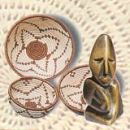craft cooperative, Zimbabwe
Gutu Baskets: Recycled plastic baskets from Gutu, Masvingo Province
Tradition and creativity have found a productive use for the plastic twine from bags used for packing maize meal, stockfeed, citrus and other foodstuffs.
The women from Gutu, in Rural Masvingo Province, skilled in basketry made from sisal and other natural fibers, now unravel the woven plastic bags and twist the threads into a cord which is then used for weaving the new colorful baskets.
Different types of plastic bags provide specific thread colors. Here is a guide to find out about the origins of your basket:
• white: maize
• fawn: stockfeed
• brown: beans
• red/orange/yellow: citrus
• black/green: vegetables
The income that the women earn from selling these baskets enables their children to go to school.
Sese Pots
Pottery that is used to hold grain and water, for preparation of food and brewing of beer, is a symbol of the closeness of the people to the land. It is also an essential part of Zimbabwe's material culture which dates back several millennia.
-- The Material Culture of Zimbabwe, H. Ellert
| "How I make pots like this" -- Mai Esinath Tobaiwa, RUDO Potter I make pots like my grandmother taught me. I collect the clay from the river banks. Then spread it on a plain surface and grind it to dust so that the clay is clean and good to be mixed with water into mud. With bits of mud in my hands I start molding the pot, building it up in a series of coils. How do I get the right shape? The shape is in my head and the mubuzo (a wooden shaping tool) in my hand. Once the pot is molded, I pattern out the designs using a sharp tool, like a bone awl. The paint we use, silver and reddish, is obtained from graphite rocks which are ground to dust. I apply the paint with my own fingers while the pot is still wet. Next I let it dry in a cool place for two days. When dry, I smooth it with a rounded river pebble. Then, let it dry some more in the sun. When completely dry it can be fired. I dig a hole in the ground, place the pot and tree bark and grass on top. The burning ashes and charcoal will fall on it and in just three hours the pot is cooked. Then I just let it cool down. The design I use is typical from my place, Chivi, in Masvingo province. At home we use these pots to cook relish and sadza, store milk or brew beer on special occasions for our family and friends. |
For pictures of RUDO's baskets, pottery and Tokwe stone carvings, view their portfolio

